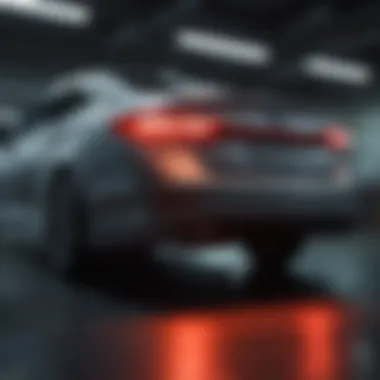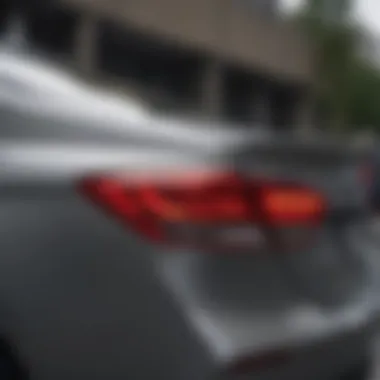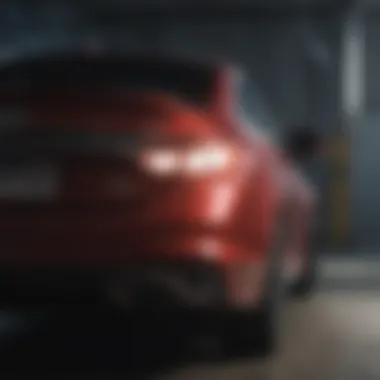Understanding the Brake Light System in 2011 Hyundai Sonata


Intro
The brake light system in the 2011 Hyundai Sonata serves a crucial role in ensuring road safety. Understanding its functionality can help owners manage maintenance, troubleshoot issues, and appreciate its importance. Brake lights alert other drivers of your intentions on the road, significantly impacting safety. Yet, many fail to recognize the complexity behind their operation. This article will delve into the various aspects of the brake light system, including common problems, maintenance guidelines, and troubleshooting methods. By determining the nuts and bolts of this system, drivers can enhance their safety and longevity of the vehicle.
Brake Light Functionality
The brake light system primarily comprises bulbs, switches, and wiring connections. When the driver presses the brake pedal, a switch, located near the pedal, closes the circuit, illuminating the brake lights at the rear. The design ensures that both lights activate, providing a clear signal to the vehicles behind.
The 2011 Hyundai Sonata features traditional incandescent bulbs for the brake lights. This setup allows for quick illumination but may not have the longevity or efficiency of newer LED systems. Nonetheless, the straightforward operation of the Sonata's brake lights generally leads to fewer complex failures.
Common Issues
Identifying issues quickly can prevent safety compromises and costly repairs. Users of the 2011 Hyundai Sonata may face several common brake light problems:
- Burnt-out bulbs: Routine checks can identify this easily. Replacing a burnt bulb is straightforward and can be done in minutes.
- Faulty switch: If your brake lights do not illuminate when pressing the brake pedal, the switch may need replacement.
- Wiring issues: Damaged wiring can disrupt the electrical circuit, leading to malfunctioning brake lights. This requires a technician to repair.
Maintenance Tips
Consistent maintenance is essential for the reliable performance of brake lights. Here are a few tips for Sonata owners:
- Regular inspection: Monthly checks can help detect burnt-out bulbs or unusual dimming.
- Keep connections clean: Ensure that wiring connections remain free of corrosion.
- Prompt replacements: Change burnt bulbs immediately to avoid penalties and stay safe.
Troubleshooting Procedures
If faced with brake light problems, follow these troubleshooting steps:
- Check the bulbs: Start by inspecting the bulbs. Replace if necessary.
- Assess the brake switch: Locate the switch near the brake pedal and test it by pressing the pedal. If it does not activate, it may need replacement.
- Inspect wiring: Trace the wiring for any visible damage. Check for loose connections.
If these steps do not resolve the issue, consider professional assistance to diagnose further.
Ending
Grasping the brake light system's functionality and maintenance is vital for safe driving. While the 2011 Hyundai Sonata is generally reliable, being proactive about brake light upkeep ensures safety on the road. A little diligence can prevent serious accidents or mishaps, contributing to road safety for all.
Preface to the Brake Light System
The brake light system plays a critical role in vehicle safety by alerting other drivers when a vehicle is slowing down or stopping. For the 2011 Hyundai Sonata, understanding this system is both essential and beneficial. It can prevent accidents, ensure compliance with legal requirements, and promote a smoother flow of traffic. A functioning brake light system is not just a luxury; it is a legal necessity.
There are specific components that work together in this system. Knowing the purpose and functioning of these elements can help owners maintain their vehicle properly. Moreover, being aware of how to troubleshoot common issues related to brake lights ensures peace of mind for both the driver and other road users. The following segments will delve deeper into the key elements, covering the intricacies of brake lights and their significance in the day-to-day operation of the 2011 Hyundai Sonata.
Purpose of Brake Lights
Brake lights serve two main purposes: they indicate when a vehicle is decelerating and they enhance overall road safety. When a driver presses the brake pedal, the brake lights illuminate automatically, signaling to trailing vehicles the intent to slow down or stop. This communication is vital; it helps to prevent rear-end collisions, which are among the most common types of accidents on the road. By providing a clear visual cue, brake lights significantly enhance situational awareness for all drivers nearby.
Furthermore, the presence of functioning brake lights is often mandatory and subject to state regulations. Both drivers and pedestrians rely on these signals for safety. Thus, ensuring they are functional is essential not only for the driver’s safety but also for the public’s well-being.
Overview of the Hyundai Sonata
The 2011 Hyundai Sonata stands out in its class for several reasons, including its design, performance, and technology features. As a midsize sedan, it offers a balanced combination of practicality and style. This model is equipped with a variety of safety features that boost its appeal, including the brake light system. Understanding how this specific brake light system operates can provide valuable insights into the overall performance and reliability of the vehicle.
Owners of the 2011 Sonata should appreciate the unique setup of the brake lights, which involves a series of components and circuits designed to function seamlessly. This car model emphasizes safety, and its brake lights play a significant part in this ethos. As such, a comprehensive understanding of these systems will enhance the driving experience and maintain the vehicle's safety credentials.
Brake Light Components


Understanding the brake light components is crucial for any driver, especially for those who own a 2011 Hyundai Sonata. The brake light system comprises multiple parts that work in unison to ensure visibility and safety on the road. Familiarity with these components not only aids in troubleshooting issues but also contributes to informed maintenance practices.
Types of Brake Lights
The 2011 Hyundai Sonata utilizes several types of brake lights, each serving a distinct role in signaling the driver's intentions to other road users. The main types include:
- High-mounted brake light: This is positioned at the rear of the vehicle above the rear window. It becomes particularly important for enhancing visibility when the vehicle is stopped in traffic.
- Standard rear brake lights: These are located at both sides of the vehicle’s rear. They activate whenever the driver presses the brake pedal, alerting drivers behind them about the deceleration.
- LED brake lights: Many modern vehicles, including the Sonata, come equipped with LED lights that offer brighter illumination and longer lifespan compared to traditional bulbs. They activate more quickly, improving response time for vehicles behind.
The understanding of these types is vital for ensuring they function effectively, as each contributes to overall driving safety.
Wiring and Connections
The wiring and connections associated with the brake light system are fundamental to its operation. In the Sonata, the wiring connects the brake lights to the switch and the vehicle's electrical system. Any damage or wear in these wiring components can lead to brake lights malfunctioning.
- Wire integrity: The quality of wiring plays an essential role. Insulated wires prevent electrical shorts. Regular checks can help identify frayed or damaged wires that require replacement.
- Connectors: The connectors link the wiring to the brake lights and switch. Loose or corroded connectors can disrupt the brake light functionalities. A proper connection ensures that electrical signals reach the lights without interruption.
Careful attention to the wiring and connections will reduce the likelihood of brake light issues, promoting safer driving.
Brake Light Switch Mechanics
The brake light switch is a key component that activates the brake lights when the pedal is pressed. In the 2011 Hyundai Sonata, this switch is typically located near the brake pedal assembly. Understanding how this switch operates helps in diagnosing potential failures.
- Functionality: When the driver presses the brake pedal, the switch closes the circuit, causing the brake lights to illuminate. This mechanical action is critical for letting other drivers know when you are slowing down.
- Common issues: A malfunctioning switch may result in brake lights staying on or not illuminating at all. Routine checks can help catch these issues before they escalate.
- Adjustments: Sometimes, the switch may need adjustments to ensure it responds accurately to pedal pressure.
By familiarizing oneself with the brake light switch mechanics, drivers can maintain effective communication with other road users, thereby enhancing safety.
Functionality of Brake Lights
The functionality of brake lights serves as a cornerstone of vehicular communication and safety. This system not only alerts following drivers about the stopping action of the vehicle but also significantly reduces the likelihood of rear-end collisions. Understanding how brake lights work is crucial for vehicle owners and those interested in automotive safety standards. In the 2011 Hyundai Sonata, the brake light system is designed with precision, ensuring that notifications to other drivers are timely and effective. Familiarity with its operation enhances user awareness and contributes to safe driving practices.
How Brake Lights Activate
Brake lights in the 2011 Hyundai Sonata activate based on a simple, yet effective mechanism. When the driver presses the brake pedal, a switch, located near the pedal, is triggered. This switch completes the electrical circuit that powers the brake lights. The lights then illuminate, signaling the intention to slow down or stop. The engaging of the brake light system can be categorized into two key actions:
- Initial Activation: This is when the driver first applies pressure to the brake pedal. The switch responds almost instantaneously, making the brake lights noticeable to drivers behind.
- Continuous Activation: As long as the driver maintains pressure on the brake pedal, the lights remain on, allowing for long-distance signaling.
This responsiveness is vital for preventing accidents. Minor delays in activation could lead to misunderstandings on the road.
Signaling Other Drivers
The role of brake lights extends beyond merely turning on; they function as a crucial signaling tool for other drivers. By indicating the vehicle's deceleration, brake lights play a pivotal role in promoting safe driving dynamics. The efficacy of this communication can be broken down into several components:
- Visibility: Properly functioning brake lights enhance visibility for following drivers, particularly in low-light conditions.
- Predictability: Frequent and predictable brake light usage helps establish patterns that other motorists can learn and anticipate, thereby reducing confusion on the road.
- Safety Distance: When brake lights illuminate promptly, it grants following vehicles ample time to adjust their speed or position in relation to the braking vehicle, mitigating risks of collision.
"Effective signaling through brake lights is fundamental for maintaining road safety and preventing accidents."
Understanding how the brake lights communicate with other drivers in a 2011 Hyundai Sonata is essential for all drivers, improving their ability to navigate safely in various conditions.
Common Issues with Brake Lights
Understanding common issues with brake lights is crucial for any owner of the 2011 Hyundai Sonata. Brake lights serve an essential role in ensuring safety on the road. When they malfunction, they can lead to dangerous situations. Knowledge of potential problems allows for proactive maintenance, which can save time and money in the long run. Three common areas of concern are burnt-out bulbs, faulty brake light switch, and wiring problems. Each of these issues will be explored in more detail below.
Burnt-Out Bulbs


One of the most frequent problems encountered with brake lights is burnt-out bulbs. Over time, the filament within the bulb can deteriorate and fail. This failure often goes unnoticed until a driver receives notification from another vehicle or during routine maintenance.
To check if a bulb is burnt out, one can visually inspect it or test it using a multimeter. Replacing burnt-out bulbs is generally straightforward.
- Open the trunk or access the tail light assembly.
- Remove the old bulb from its socket.
- Insert a new bulb appropriate for the 2011 Hyundai Sonata. Ensure it clicks securely.
Doing so can restore the functionality of your brake lights nearly instantly. Regular inspections can prevent the issue from arising unexpectedly.
Faulty Brake Light Switch
A faulty brake light switch is another common cause of brake light malfunction. This switch, located usually near the brake pedal, is responsible for signaling the brake lights to illuminate when the pedal is pressed. If the switch fails, the brake lights may not activate at all, leading to potential safety hazards.
Identifying a faulty brake light switch involves:
- Pressing the brake pedal while observing if the lights illuminate.
- If the lights do not activate, further testing with a multimeter may be required to check for electrical continuity.
If the switch is determined to be faulty, replacement is the best course of action. Ensure to consult the car manual for specific instructions on switching out the brake light switch safely.
Wiring Problems
Wiring problems can also lead to issues with brake lights. Damaged wires can result from wear and tear over time or exposure to the elements. Corrosion, fraying, or breaks in the wiring can disrupt the current flow, leading to malfunctioning lights.
To diagnose wiring problems:
- Inspect the wiring harness leading to the brake lights for any visible damage, such as cuts or corrosion.
- Use a multimeter to check the continuity of the wires. This step will help in identifying any breaks in the line.
If wiring issues are found, it may be necessary to repair or replace damaged sections. This task can be more complex and may require the assistance of a professional to ensure that it is done correctly.
Regular inspection of components such as bulbs, switches, and wiring is essential for ensuring the safety and functionality of brake lights. A moment of preventative care can go a long way.
Troubleshooting Brake Light Problems
Troubleshooting brake light problems is an essential step for maintaining safety while driving your 2011 Hyundai Sonata. The brake lights are not merely indicators; they signal to other drivers your intention to stop. Failing to address brake light issues can lead to accidents and legal complications. Understanding how to troubleshoot these problems can save time and prevent costly repairs. It enhances your awareness of the vehicle's systems and ensures compliance with safety regulations.
Initial Checks
Performing initial checks should be your first step in troubleshooting. These checks can often identify simple problems without requiring specialized tools.
- Inspect the Bulbs: Start by examining the brake light bulbs. Look for any signs of burnouts or damage. A non-functioning bulb is usually the most straightforward issue.
- Check the Fuse: Locate the fuse box and check the fuse associated with the brake lights. If it’s blown, replacing it can quickly restore functionality.
- Examine the Light Switch: Sometimes, the issue might lie in the brake pedal switch. Ensure that it is not stuck or damaged; a malfunction can prevent activation.
Using a Multimeter
A multimeter is a valuable tool for diagnosing electrical issues in the brake light system. If initial checks do not resolve the problem, further testing may be necessary.
- Test the Voltage: Set the multimeter to measure voltage. With the brake pedal pressed, probe the connector leading to the brake lights. A reading of around 12 volts indicates that power is reaching the lights.
- Check for Ground Issues: After verifying voltage, ensure that there is a good ground connection as well. A poor ground can prevent the lights from functioning.
- Continuity Test: You can perform a continuity test on the switch and the bulbs to ensure there are no breaks in the wiring.
Consulting a Professional Mechanic
When troubleshooting becomes overwhelming or if you lack the necessary tools, consulting a professional mechanic is advisable. Certified mechanics possess the expertise and equipment to diagnose complex issues.
- Advanced Diagnostics: A mechanic can use specialized diagnostic tools to trace issues that may not be visible during a basic inspection.
- Comprehensive Analysis: They can check all components related to the brake light system, including wiring harnesses and electronic modules, providing a thorough solution.
- Warranty Considerations: If your vehicle is still under warranty, professional diagnosis and repair may ensure compliance with warranty conditions.
Always prioritize safety when dealing with vehicle issues. Brake light failures can have serious consequences.


In summary, troubleshooting brake light problems is crucial for safe driving and vehicle maintenance. Beginning with initial checks, using tools like multimeters, and knowing when to consult a professional can keep your brake light system functional. Take these steps seriously to avoid accidents and ensure compliance with vehicular regulations.
Maintenance of Brake Light System
Maintaining the brake light system of the 2011 Hyundai Sonata is crucial for both safety and legality. The brake lights serve as a fundamental communication tool between the driver and other road users. If these lights malfunction, it can lead to accidents, as drivers behind may not be aware when the vehicle is stopping or slowing down. Regular maintenance not only minimizes the risk of brake light failure but also contributes to vehicle longevity. Proper upkeep of this system can save time and money, preventing larger issues from developing down the road.
Routine Inspections
Routine inspections of the brake light system are a simple yet effective way to ensure its functionality. You should perform these inspections regularly, ideally every few months or at least before long trips. During an inspection, check the following elements:
- Light bulbs: Look for any burnt-out or discolored bulbs.
- Wiring: Inspect wires for fraying or corrosion.
- Connections: Ensure all connections are secure.
If any problem is identified during the inspection, address it promptly. Keeping a checklist may help track the condition of the brake light system over time, making it easier to spot changes that need attention. Additionally, involve a trusted mechanic for more in-depth evaluations if you notice persistent issues during your checks.
Replacement of Bulbs
Replacing burnt-out bulbs is a straightforward task that anyone can achieve. The brake light bulbs in the 2011 Hyundai Sonata need to be replaced when they reach the end of their lifespan. When doing so, follow these steps:
- Access the Tail Light Assembly: Open the trunk and locate the tail light assembly.
- Remove the Assembly: Unscrew or unclip the assembly from the car.
- Replace the Bulb: Gently twist and pull the old bulb out. Insert the new bulb by pushing it into place and twisting it to secure.
- Reattach the Assembly: Put the tail light assembly back and ensure it is secured properly.
- Test the Bulbs: Before closing the trunk, test the brake lights to ensure they are working correctly.
This small maintenance task increases safety and can be done without professional help, saving considerable costs.
Regular maintenance of brake lights ensures safer driving conditions and helps you remain compliant with traffic regulations.
Legal Requirements and Safety Considerations
Understanding the legal requirements and safety considerations surrounding the brake light system is critical for any vehicle owner, especially those with a 2011 Hyundai Sonata. Compliance with these regulations not only ensures the vehicle’s legality on the road but also significantly contributes to the safety of the driver, passengers, and others on the road.
State Regulations on Brake Lights
Each state has its own regulations regarding vehicle lighting, including brake lights. These laws dictate the requirements for the number, color, and functionality of brake lights.
- Number of Lights: Most states require at least two functioning brake lights that are located symmetrically on the rear of the car.
- Color Standards: Typically, brake lights must emit a red light. Some regulations specify that the lights must not be obscured or altered in any way from the manufacturer’s original specifications.
- Testing and Maintenance: Some states may impose checks during annual inspections to ascertain that the brake lights are fully operational.
Failure to adhere to these regulations can result in fines and issues with vehicle registration. Additionally, knowing your state’s requirements can help prevent safety hazards arising from malfunctioning or inadequate brake lights.
Impact on Vehicle Safety
The impact of functioning brake lights on vehicle safety cannot be overstated. Brake lights serve as essential indicators signaling to other drivers when a vehicle is slowing down or coming to a stop.
- Prevention of Accidents: Properly functioning brake lights significantly reduce the risk of rear-end collisions. Other drivers rely on these signals to maintain safe distances, especially in heavy traffic.
- Visibility: In low-light conditions or adverse weather, working brake lights enhance visibility, which is invaluable for warning drivers behind you of impending stops.
"The brake light system is a vital safety feature that directly influences road safety and must be maintained to ensure effectiveness."
Maintaining the brake light system involves routine inspections to ensure all components are functioning. Regularly checking the lights can be a part of a general vehicle maintenance routine, promoting not just compliance with laws but also contributing to overall road safety.
By understanding the legalities and safety implications concerning brake lights, owners of the 2011 Hyundai Sonata can greatly enhance their driving experience, making the roads safer for everyone.
Finale
The brake light system in the 2011 Hyundai Sonata holds significant importance for both safety and functionality on the road. Understanding how this system operates and the common issues that may arise allows drivers to maintain their vehicles effectively. This knowledge contributes not only to individual safety but also to the safety of other road users.
Summary of Key Points
- The brake light system serves a vital role in signaling the driver’s intentions to other road users.
- Utilizing components like bulbs, switches, and wiring to create a seamless operation is fundamental to the system's functionality.
- Recognizing common issues such as burnt-out bulbs or faulty switches can save time and money on repairs.
- Regular maintenance and checks can prevent most issues before they become critical.
- Awareness of legal regulations regarding brake lights ensures compliance and enhances safety.
Final Recommendations
For drivers of the 2011 Hyundai Sonata, regular inspection of the brake light system is advisable. Replace burnt-out bulbs promptly to avoid mishaps. Additionally, if issues persist, consulting a professional mechanic can provide solutions that ensure the brake lights function as intended. Taking proactive measures enriches the motoring experience and secures the well-being of drivers and pedestrians alike.







